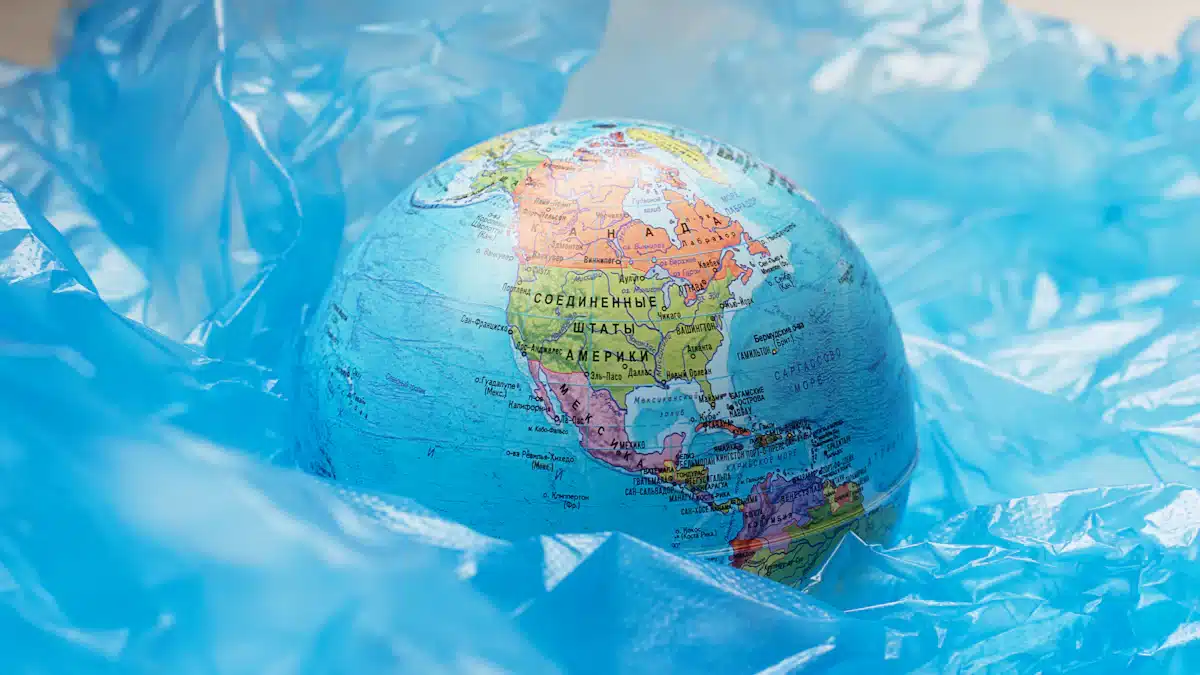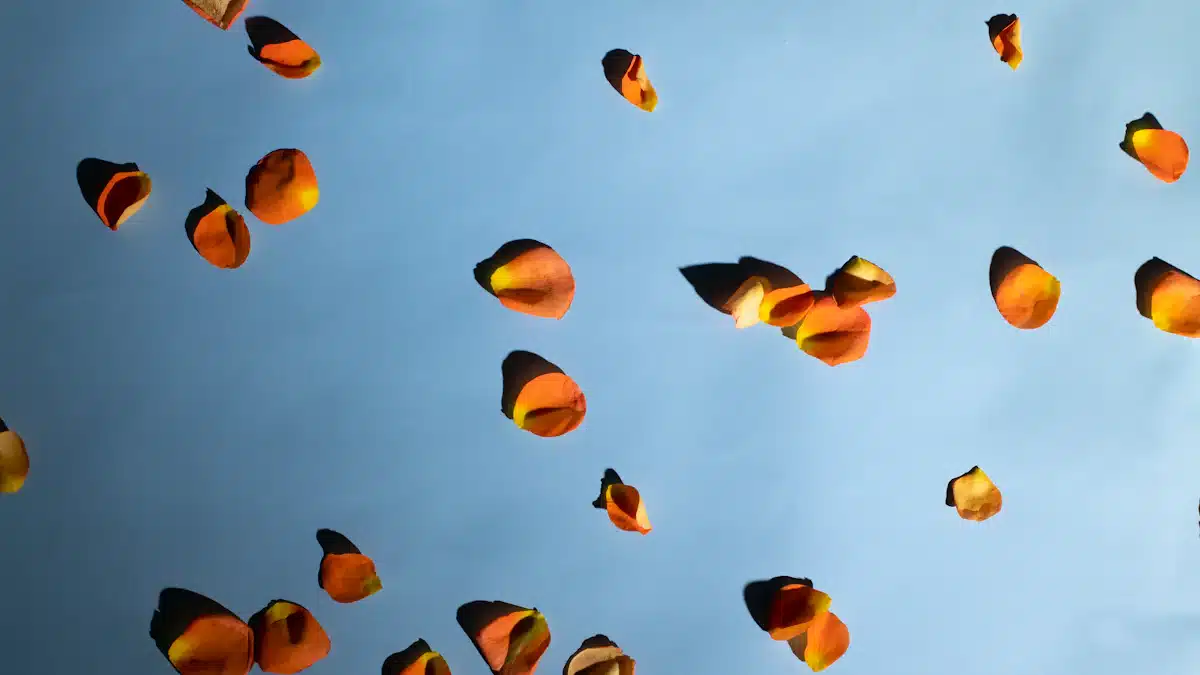
Latex balloons are often labeled as eco-friendly balloons, but their biodegradability is not as straightforward as it seems. These balloons can persist in the environment for years, especially in water or soil. Studies show that latex balloons remain intact for over 16 weeks in various conditions and may take 15 years or longer to decompose in freshwater or marine environments. This slow breakdown process raises concerns about their impact on ecosystems. Choosing sustainable alternatives can help reduce pollution and protect wildlife from harm.
Key Takeaways
Latex balloons do not break down as fast as claimed. They may take 15 years or more to decompose, especially in water.
Things like humidity, temperature, and sunlight affect how fast latex balloons decay.
Using eco-friendly options, like fabric decorations or compostable supplies, can cut pollution and protect animals.
False claims about biodegradable balloons can lead to harmful actions, like balloon releases, which can hurt wildlife.
Fun celebration ideas without balloons can be festive and eco-friendly, helping the planet while reducing harm.
What Does Biodegradable Mean for Latex Balloons?
Definition of Biodegradability
Biodegradability refers to the ability of a material to break down naturally into harmless substances through the action of microorganisms. For latex balloons, this means they should decompose into organic matter without leaving harmful residues. However, the process depends heavily on environmental factors like temperature, moisture, and exposure to sunlight. Research shows that latex balloons often fail to degrade as quickly as claimed. For example, a study found that biodegradable balloons remained intact for seven years, even in harsh conditions. Another study from 2021 revealed that latex balloons retained their shape for 16 weeks, suggesting minimal degradation during that time.
Materials Used in Biodegradable Balloons
Biodegradable balloons are typically made from natural latex, which comes from the sap of the Hevea brasiliensis tree. This process is similar to harvesting syrup and results in a 100% natural product. Natural latex is biodegradable and considered an eco-friendly alternative to synthetic materials. However, some biodegradable latex balloons may include additives like polychloroprene or pigments, which can slow the decomposition process. These chemical fillers often leave residues that disrupt soil composition and harm ecosystems. While natural latex balloons are marketed as eco-friendly, their environmental impact depends on how they are manufactured and disposed of.
Are Latex Balloons Truly Biodegradable?
Latex balloons are biodegradable under ideal conditions, but the process is far from quick. Claims that latex balloons degrade like oak leaves are misleading. Recent studies show that latex balloons can take 15 years or more to fully decompose, especially in marine environments. During this time, they contribute to litter and pose risks to wildlife. Marine animals often mistake balloon fragments for food, leading to ingestion and starvation. Additionally, balloon strings can entangle coral reefs, further harming marine biodiversity. While natural latex balloons are a better option than synthetic ones, they are not a perfect solution for reducing environmental harm.
How Long Do Latex Balloons Take to Decompose?

Factors Influencing Decomposition
The decomposition of latex balloons depends on several environmental factors. You might think that latex, being a natural material, would break down quickly, but this isn’t always the case. Various conditions can either speed up or slow down the process:
Humidity: Moisture affects the structural integrity of latex balloons. Over time, exposure to high humidity can weaken the material, making it more susceptible to decomposition.
Temperature: Warm environments accelerate the breakdown of latex, while cooler conditions slow it down. On foggy days, you may notice balloons feel softer due to the combined effects of temperature and moisture.
Sunlight: UV rays from the sun help degrade latex by breaking down its molecular structure. Balloons left in direct sunlight decompose faster than those in shaded areas.
These factors highlight why latex balloons decompose at different rates depending on where they end up after use.
Scientific Studies on Latex Balloon Decomposition
Scientific research reveals that latex balloons decompose at a rate similar to natural materials like oak leaves. This means they are biodegradable, but the process is far from immediate. Studies show that latex balloons can take months or even years to break down completely. For example, one study found that balloons retained their shape for over 16 weeks in various conditions. Another study documented the role of bacteria in breaking down latex, a process that has been observed since 1914. While microorganisms play a crucial role, environmental conditions like moisture and light exposure significantly influence the speed of decomposition.
Comparison to Other Biodegradable Materials
When compared to other biodegradable materials, latex balloons fall short in terms of environmental impact.
Biodegradable balloons can take months or even years to decompose, depending on the conditions.
Chemical fillers in some balloons hinder their biodegradability, leaving harmful residues in soil and water.
Unlike materials like paper or compostable plastics, latex balloons pose a greater risk to wildlife and ecosystems.
Although marketed as eco-friendly, biodegradable balloons still contribute to pollution and disrupt natural habitats. Choosing truly sustainable alternatives can help minimize these impacts.
Environmental Impact of Latex Balloons

Effects on Wildlife and Ecosystems
Latex balloons pose significant risks to wildlife and ecosystems. Animals often mistake deflated balloons for food. For example, sea turtles confuse them with jellyfish, leading to digestive blockages and malnutrition. This can make them more vulnerable to predators. Balloon strings also create hazards. Wildlife, such as birds, can become entangled, restricting their movement and causing injuries or death. In Florida, sea turtles have been documented ingesting balloons, while in the UK, a seagull died after becoming trapped in a balloon string. These incidents highlight how biodegradable balloons, despite their claims, still harm animals.
Balloons contribute to litter in natural environments. Marine animals, including whales and dolphins, have been found with balloon fragments in their stomachs. This ingestion often leads to starvation or internal injuries. In Australia, reports show that marine life faces increasing threats from balloon debris drifting into the ocean. The environmental impact of latex balloons extends beyond individual animals, disrupting entire ecosystems.
Contribution to Plastic and Chemical Pollution
Biodegradable latex balloons degrade slowly, taking months or even years to break down. During this time, they contribute to balloon pollution, which poses a greater risk to wildlife than other litter, such as bottle caps. Animals ingest balloon fragments, leading to internal injuries or death. Strings and ribbons further entangle and suffocate wildlife.
The production of balloons relies on non-renewable resources derived from fossil fuels. This makes them wasteful products, especially since they are designed for short-term use. Additionally, the dyes and pigments used in balloons complicate their decomposition. These chemicals can leach into soil and water, disrupting ecosystems and harming organisms. While marketed as eco-friendly balloons, their environmental impact remains significant.
Misleading Claims About Biodegradable Balloons
Manufacturers often make misleading claims about biodegradable balloons. They promote hand-tied latex balloons as environmentally friendly, but added chemicals and dyes hinder their biodegradability. Many people mistakenly believe releasing these balloons is safe. However, balloons can take up to four years to degrade, posing risks to wildlife during this time.
Some manufacturers compare latex balloons to natural materials like oak leaves, claiming similar decomposition rates. This comparison is misleading. Unlike oak leaves, balloons harm wildlife and ecosystems. A 1969 industry-funded study supported these claims, but it was never peer-reviewed. The study ignored the environmental dangers posed by balloons. Marketing biodegradable latex balloons as eco-friendly misleads consumers and encourages harmful practices like balloon releases.
Eco-Friendly Alternatives to Latex Balloons
Reusable and Sustainable Decorations
You can replace latex balloons with reusable and sustainable decorations that are both beautiful and environmentally friendly. Consider using fabric bunting or flags, which add a festive touch and can be reused for multiple events. Paper decorations, such as lanterns or colorful chains, are another great option. These can be made from recycled materials, making them a sustainable choice.
Natural decorations like flowers, plants, or pine cones bring a touch of nature to your celebrations. Wooden ornaments or light shows, such as colorful projections, also create a magical atmosphere without harming the environment. These alternatives not only reduce waste but also eliminate the risks latex balloons pose to wildlife and ecosystems.
Truly Biodegradable Party Supplies
Switching to truly biodegradable party supplies ensures your celebrations leave no lasting harm on the planet. Compostable party bowls and cups made from plant-based materials, like sugarcane bagasse or corn starch, are excellent options. Compostable cutlery and straws crafted from maize starch also provide eco-friendly solutions.
These supplies break down naturally and do not contribute to pollution. Unlike latex balloons, which can take years to decompose, these biodegradable items return to the earth quickly and safely. By choosing these products, you support sustainable practices and reduce your environmental footprint.
Creative Celebration Ideas Without Balloons
Celebrating without balloons opens the door to creative and eco-friendly alternatives. Tissue paper balls mimic the look of balloons while being recyclable. Reusable fabric buntings and DIY glitter banners add a personal touch to your decorations. Party fans, made from paper, offer a colorful and festive vibe.
For a unique twist, consider ribbon dancers or pinwheels made from recycled materials. Kites, crafted from paper and wood, provide a fun floating experience similar to balloons. These ideas not only reduce waste but also inspire creativity and sustainability in your celebrations.
Latex balloons are biodegradable, but the process is slow and depends on environmental factors like temperature and moisture. Research shows they can take six months to four years to decompose, often leaving residues from chemical fillers and pigments. This slow breakdown harms wildlife, as birds and marine animals ingest balloon fragments, leading to fatal blockages or starvation.
You can reduce this impact by choosing sustainable alternatives. Decorations like bunting, banners, or paper chains create festive atmospheres without harming ecosystems. Proper disposal methods for party supplies also help protect the environment. By making thoughtful choices, you can celebrate responsibly while preserving nature.
FAQ
What makes latex balloons biodegradable?
Latex balloons are made from natural rubber, which microorganisms can break down. This process turns the material into organic matter. However, environmental factors like sunlight, moisture, and temperature affect how quickly this happens.
How long does it take for a latex balloon to decompose?
A latex balloon can take anywhere from six months to four years to decompose. In marine environments, it may take even longer. Factors like humidity and UV exposure play a significant role in the breakdown process.
Are balloon releases harmful to the environment?
Yes, balloon releases harm the environment. Balloons often end up in oceans or forests, where animals mistake them for food. This leads to injuries, starvation, or death. Strings also entangle wildlife, causing further harm.
Can you recycle latex balloons?
No, you cannot recycle latex balloons. Most recycling facilities do not accept them due to their material composition. Proper disposal, like cutting them into small pieces and throwing them in the trash, is the best option.
What are some eco-friendly alternatives to balloons?
You can use paper decorations, fabric buntings, or natural elements like flowers. Reusable items like lanterns or wooden ornaments also work well. These options reduce waste and protect wildlife while still creating a festive atmosphere. 🎉






13 thoughts on “Are Latex Balloons Truly Biodegradable in 2025”
Pingback: Top Clear Latex Balloons For Event Decorations In 2025
Pingback: Eco-Friendly Fun With Latex-Free Water Balloons Reviewed
Pingback: Gender Reveal Balloons Made Easy For Parties
Pingback: Foil Balloons Vs Latex Balloons For 30th Celebrations
Pingback: Different Types Of Pink Balloons You Can Find
Pingback: Balloon Arch Design Trends Shaping 2025 Events
Pingback: Tips For Hosting An Eco-Conscious Event With Balloons In London
Pingback: Creative Personalised Latex Balloon Designs To Try This Year
Pingback: Top Balloon Table Decor Trends For Weddings And Parties In 2025
Pingback: Everything You Should Know About Biodegradable Balloons In 2025
Pingback: What Are Sempertex Balloons And Their Unique Features
Pingback: Tips For Picking The Best Biodegradable Water Balloons
Pingback: Foil Balloons vs Latex Balloons for Bride Decor in 2025 – Chaoee